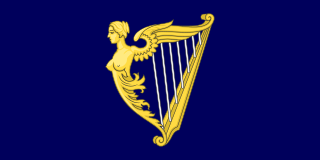
The Kingdom of Ireland was a dependent territory of England and then of Great Britain from 1542 to the end of 1800. It was ruled by the monarchs of England and then of Great Britain, and was administered from Dublin Castle by a viceroy appointed by the English king: the Lord Deputy of Ireland. Aside from brief periods, the state was dominated by the Protestant English minority. The Protestant Church of Ireland was the state church. The Parliament of Ireland was composed of Anglo-Irish nobles. From 1661, the administration controlled an Irish army. Although styled a kingdom, for most of its history it was, de facto, an English dependency. This status was enshrined in Poynings' Law and in the Declaratory Act of 1719.
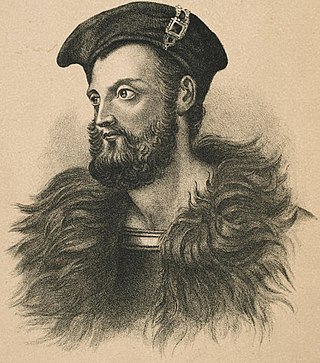
Owen Roe O'Neill was a Gaelic Irish soldier and one of the most famous of the O'Neill dynasty of Ulster. O'Neill left Ireland at a young age and spent most of his life as a mercenary in the Spanish Army serving against the Dutch in Flanders during the Eighty Years' War. After the Irish Rebellion of 1641, O'Neill returned and took command of the Irish Confederate Ulster Army. He is known for his victory at the Battle of Benburb in 1646.

The coat of arms of Saskatchewan, officially known as His Majesty's Arms in right of Saskatchewan, is the heraldic symbol representing the Canadian province of Saskatchewan.

A saltire, also called Saint Andrew's Cross or the crux decussata, is a heraldic symbol in the form of a diagonal cross. The word comes from the Middle French sautoir, Medieval Latin saltatoria ("stirrup").
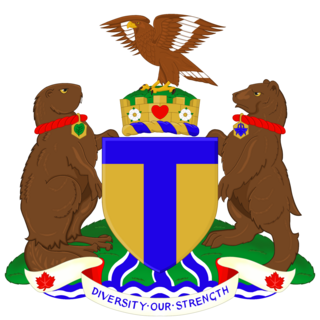
The coat of arms of Toronto is a heraldic symbol used to represent the city Toronto. Designed by Robert Watt, the Chief Herald of Canada at the time, for the City of Toronto after its amalgamation in 1998. The arms were granted by the Canadian Heraldic Authority on 11 January 1999.
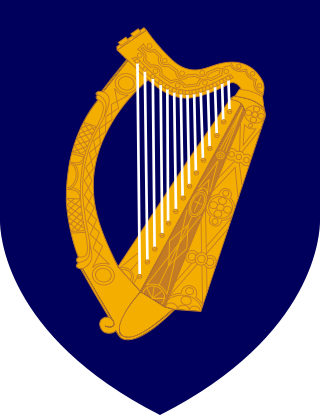
The coat of arms of Ireland is blazoned as Azure a harp Or, stringed Argent. These arms have long been Ireland's heraldic emblem. References to them as being the arms of the king of Ireland can be found as early as the 13th century. These arms were adopted by Henry VIII of England when he ended the period of Lordship of Ireland and declared Ireland to be a kingdom again in 1541. When the crowns of England, Scotland and Ireland were united in 1603, they were integrated into the unified royal coat of arms of kingdoms of England, Scotland and Ireland. The harp was adopted as the emblem of the Irish Free State when it separated from the United Kingdom in 1922. They were registered as the arms of Ireland with the Chief Herald of Ireland on 9 November 1945.
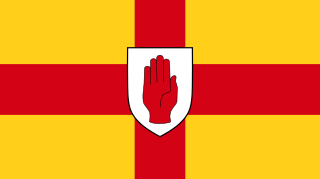
The flag of Ulster is a banner based on the coat of arms of Ulster, used to represent Ulster, one of the four provinces of Ireland. It consists of a red cross on a gold background with a red hand on a white shield in the centre.
In British heraldry, vert is the tincture equivalent to green. It is one of the five dark tinctures called colours.

The coat of arms of Sierra Leone, were developed by the College of Arms and granted in 1960.
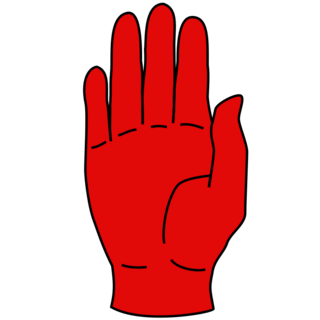
The Red Hand of Ulster is a symbol used in heraldry to denote the Irish province of Ulster and the Northern Uí Néill in particular. It has also been used however by other Irish clans across the island, including the ruling families of western Connacht and the chiefs of the Midlands.

Saint Patrick's Saltire or Saint Patrick's Cross is a red saltire on a white field. In heraldic language, it may be blazoned argent, a saltire gules. Saint Patrick's Flag is a flag composed of Saint Patrick's Saltire. The origin of the saltire is disputed. Its association with Saint Patrick dates from the 1780s, when the Anglo-Irish Order of Saint Patrick adopted it as an emblem. This was a British chivalric order established in 1783 by George III. It has been suggested that it derives from the arms of the powerful Geraldine or FitzGerald dynasty. Some Irish nationalists and others reject its use to represent Ireland as a "British invention" "for a people who had never used it".
In heraldry and heraldic vexillology, a blazon is a formal description of a coat of arms, flag or similar emblem, from which the reader can reconstruct the appropriate image. The verb to blazon means to create such a description. The visual depiction of a coat of arms or flag has traditionally had considerable latitude in design, but a verbal blazon specifies the essentially distinctive elements. A coat of arms or flag is therefore primarily defined not by a picture but rather by the wording of its blazon. Blazon is also the specialized language in which a blazon is written, and, as a verb, the act of writing such a description. Blazonry is the art, craft or practice of creating a blazon. The language employed in blazonry has its own vocabulary, grammar and syntax, which becomes essential for comprehension when blazoning a complex coat of arms.

The coat of arms of North Rhine-Westphalia is the official coat of arms of the German state of North Rhine-Westphalia.

The coat of arms of Munster consists of three gold crowns on a blue field. Similar crowns were included on the arms of Ireland before being superseded by the golden harp in the 16th century.

The coat of arms of Connacht displays a vertically dimidiated black eagle and armed hand. The arms are recorded as such on a map of Galway dated 1651, now in the library of Trinity College Dublin. These arms approximate rather closely to those of the Schottenkloster, or Gaelic monastery, founded in Regensburg, Bavaria in the 11th century.
There is no cross-border flag universally accepted as representing both jurisdictions on the island of Ireland. This can be a problem in contexts where a body organised on an all-island basis needs to be represented by a flag in an international context.

Middletown Eoghan Rua Gaelic Athletic Club, also known as Eoghan Ruadh, is a GAA club from Middletown, County Armagh, Northern Ireland. The club fields teams from under-10 level to senior level in Gaelic football, hurling and camogie; all teams use the club colours of black and white with the males playing with vertical stripes. Middletown has won many county championship and league titles, and has been successful in All Ireland club championships. The club plays at P.J. O'Neill Park.

The coat of arms of Ulster consists of an inescutcheon Argent displaying a red hand, upon the coat of arms of the ancient Anglo-Norman and Hiberno-Norman noble dynasty, the House of Burgh.

The Battle of Clones occurred on 13 June 1643 during the Irish Confederate Wars, when Irish Confederate forces commanded by Eoghan Ruadh Ó Néill were decisively defeated near Clones in County Monaghan by the Protestant Laggan Army commanded by Sir Robert Stewart.
Owen Roe most commonly refers to Owen Roe O'Neill, an Irish nobleman and military leader, or to institutions named for him:





















